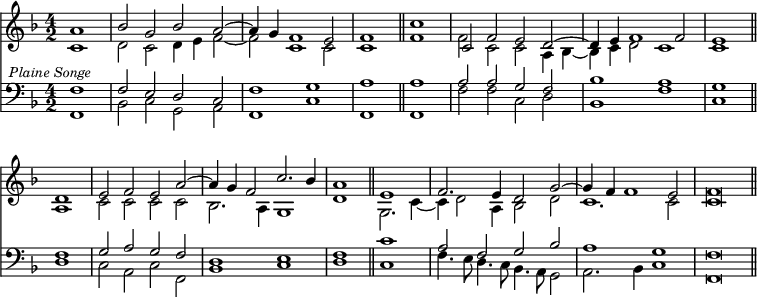'French tune,' from Ravenscroft's 'Booke of Psalmes,' 1621.

A second edition of Ravenscroft's Psalter was published in 1633. William and Henry Lawes set the Psalms of Mr. George Sandys, in three parts, in 1648. In 1671, John Playford printed his 'Psalms and Hymns in solemn Musicke of foure parts;' followed, in 1677, by his more widely known 'Whole Book of Psalms' for three voices—a work, the popularity of which was so extended, that, by the year 1757, it had run through no less than twenty editions. But these later works show a lamentable deterioration both of technical skill and artistic feeling. English Hymnody was not destined to remain for any length of time in the high state of cultivation indicated by the collections of Este and Ravenscroft. Step by step the decadence of the Hymn Tune kept pace with that of the Madrigal, which had once done so much towards preparing the way for its more perfect development. Had any hope of a revival existed, it would have been dispelled by the Great Rebellion. The Restoration did nothing towards the resuscitation of the failing Art. The vigorous treatment of the old Masters faded gradually into vague inanity. The Tunes of Hayes, Wainwright, Carey, Tans'ur, and other more modern writers, are as far inferior to those of their predecessors as those of their followers are to them. The popular taste grew daily more and more corrupt; until, about the beginning of the present century, it reached a pitch of degradation beneath which it would seem impossible that it could ever sink. At that hopeless level it remained for many years. Not a few of us can remember when the most popular Hymn Tune in England—that known as 'Helmsley,' set to the hymn 'Lo, he comes with clouds descending'—was an air of so sæcular a character, that it had probably been composed to some amatory verses, beginning
'Guardian Angels, now protect me,
Send me back the youth I love'—
sung by Mistress Anne Catley, in 'The Golden Pippin'; and danced, as a hornpipe, at Sadlers' Wells. [See Lo, he comes.]
In O'Hara's burletta, 'The Golden Pippen,' Covent Garden.
![{ \time 4/4 \key a \major \autoBeamOff \relative a' { \repeat volta 2 { a4 cis8[ e] d[ b] gis[ e] | a8.[ b32 cis] b8[ a] gis[ fis] e4 | a8[ e] a[ cis] b[ e,] b'[ d] | cis8.[ d32 e] d8[ cis] \appoggiatura cis4 b2 } } \addlyrics { Where's the _ mor -- _ tal _ can _ _ re -- _ sist _ me? Queens _ must _ e -- ve -- ry _ hon -- _ _ our _ gain. } }](http://upload.wikimedia.org/score/4/n/4n7ad0w9ak2f8g5h88vntb2vlbpyzeb/4n7ad0w9.png)
'Miss Catley's Hornpipe.' Danced at Sadlers' Wells.

The Advent Hymn. (Helmsley Tune.)
![{ \time 4/4 \key a \major \relative a' { \repeat volta 2 { a4 cis8[ e] a,[ gis] fis[ e] | fis8.[ gis16] \acciaccatura b8 a[ gis16( fis)] e8.[ d16] cis4 | e8.[ fis16 e8] e a8.[ b16 a8] b | cis[ e] d[ cis] cis4 b } } }](http://upload.wikimedia.org/score/q/i/qihojsfjzeoakrfit13j4zbfz3z7s25/qihojsfj.png)
The real objection to such melodies as this lies, less in their origin, than in their esoteric unfitness for the purpose to which they are so inappropriately applied. The one may, in time, be forgotten—the other, never. Few people, nowadays, are acquainted with the source of 'Helmsley': but no one who has seen a Hornpipe danced can mistake its Terpsichorean animus—and, surely, no possible animus could be less fitted to harmonise with the feelings which should be excited by a Hymn on the Last Judgment. Nun ruhen alle Wälder, and O Welt, ich muss Dich lassen, were originally saecular airs: but, how different their character!
Vigorous efforts have recently been made, and are made still, to introduce something better. But public taste seems scarcely leading in a hopeful direction. Where Plain Chaunt is affected, the melodies are too frequently tortured beyond all possibility of recognition; while they are invariably accompanied by harmonies which utterly destroy their distinctive character—passionate dissonances, unblushingly stolen from the theatre, and only fitted to illustrate the romance of Der Freischütz or the deep tragedy of Lucia di Lammermoor. Palestrina's exquisite settings are undoubtedly too difficult for general use; though they lie quite within the compass of an ordinary Cathedral Choir. But, apart from these, few things in music are more beautiful than a Plain Chaunt melody, diatonically accompanied in simple counterpoint: and, surely, the art of so accompanying it is not beyond the power of an average organist! The settings of John Dowland, and Claudin le Jeune, may be sung by almost any Choir, however modest its pretensions. Ravenscroft's work has been reprinted, of late years, at a price which places it within the reach of every one. But, before the sterling Tunes contained

